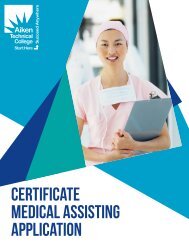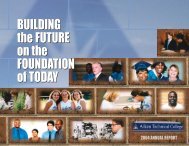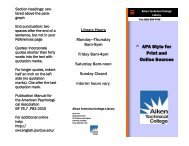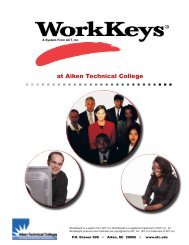2009 Accountability Report - Aiken Technical College
2009 Accountability Report - Aiken Technical College
2009 Accountability Report - Aiken Technical College
Create successful ePaper yourself
Turn your PDF publications into a flip-book with our unique Google optimized e-Paper software.
34<br />
Conference.<br />
CATEGORY 5 – WORKFORCE FOCUS<br />
III.5.1. How do you organize and manage work to enable your workforce to develop and utilize their full<br />
potential, aligned with the organization’s objectives, strategies, and action plans and promote cooperation,<br />
initiative, empowerment, innovation, and your organizational culture<br />
ATC utilizes a multi-tier reporting structure within the major operating areas of the <strong>College</strong> in order to optimize<br />
operations by eliminating duplication of processes and to assign specific areas of responsibility to each division.<br />
As indicated on the organizational chart included in Section II.11, ATC has an Executive Staff which consists<br />
of the <strong>College</strong> president and the three vice presidents in charge of the four divisions: Administrative Services,<br />
Student Services, Education and Training. The Vice Presidents report to the President. Each division consists<br />
of a tier of directors/managers and lower level supervisors and other employees. Work is assigned in support of<br />
the departmental, divisional and organizational goals.<br />
Job duties and performance objectives are communicated to faculty and staff and evaluated via the performance<br />
management system. Faculty use the Faculty Performance Management System and staff use the Employee<br />
Performance Management System. These individual performance management tools are designed to facilitate<br />
employee success and to communicate expectations and success criteria to employees. There is also a section<br />
for objectives that are typically tied to the <strong>College</strong>’s annual plan and individual program plans.<br />
Throughout the <strong>College</strong>, departments have procedures in place to encourage optional and mandatory<br />
professional development. Adjunct faculty in the Training and Business Development Division are required to<br />
complete Train-the-Trainer, a course which teaches subject matter experts how to instruct, before they can<br />
begin conducting training for local business and industry. Some departments require supervisors to attend<br />
supervisory practices training. A Professional Development Committee uses a dedicated budget to support<br />
individual training activities. Additionally, the <strong>College</strong> has a diversity program geared toward improving<br />
classroom management and employee relations.<br />
Faculty and staff are empowered by participating in the development of performance management objectives<br />
and providing input into the annual planning process.<br />
Since innovation within the <strong>College</strong> may be fostered by providing additional funds, the Faculty of the Year<br />
receives a monetary award from the ATC Foundation. Faculty participating in the Faculty Academy received a<br />
stipend to recognize the time and effort they spent in improving their teaching skills. Additional funding from<br />
non-traditional sources and release time are commonly used to support these activities.<br />
III.5.2 How do you achieve effective communication and knowledge/skill/best practice sharing across<br />
departments, jobs, and locations<br />
ATC’s reporting structure consists of an Executive Staff. Communication for major initiatives usually begins at<br />
this level and is communicated downward through a multi-tier level of employees. A monthly college-wide<br />
meeting ensures that all employees within the <strong>College</strong> are “in the loop” and aware of projects, innovations and



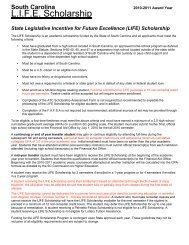
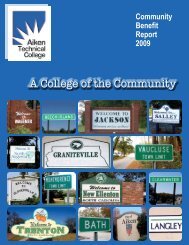
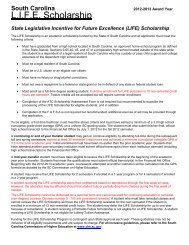
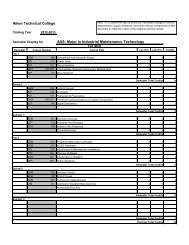

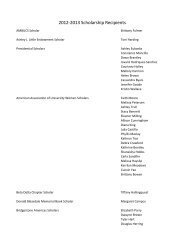
![MLA PowerPoint presentation [PDF] - Aiken Technical College](https://img.yumpu.com/36398339/1/190x143/mla-powerpoint-presentation-pdf-aiken-technical-college.jpg?quality=85)
